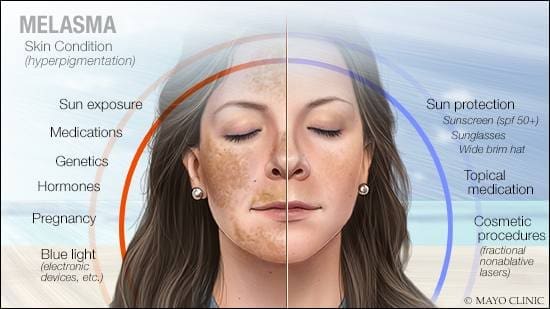
Heat Triggers Melasma
Heat significantly triggers melasma, a common skin condition with dark brown spots on the skin.
When the skin is exposed to heat, it can become hot and sensitive, setting the stage for melasma to develop. This happens because there’s a strong relationship where heat triggers melasma symptoms.
While researchers do not fully understand the exact mechanisms by which elevated temperatures contribute to this condition, they have explored several plausible theories. It is known that heat triggers melasma symptoms.
One prominent theory suggests that increased warmth stimulates the activity of melanocytes—specialized cells in the skin responsible for producing melanin, the pigment that gives skin its color. Warmth can lead to melasma as heat acts as a trigger.

Under high-temperature conditions, these melanocytes can become overly stimulated, leading to excessive melanin production. In fact, warmth is a trigger for melasma when these cells are stimulated.
Because of this extra production, dark spots can form, which are common in melasma.
Additionally, another important theory revolves around the idea that heat causes redness and inflammation in the skin. This inflammatory response can disrupt melanocyte function, leading to increased melanin production because heat triggers the melasma chain.
Because of this series of events, melasma can start and get worse. Since heat often makes melasma worse, it’s important to treat any inflammation as well.
Warmth improves the skin’s barrier, potentially allowing UV radiation, a trigger for melasma, to penetrate deeper.
The Connection Between Heat and Melasma Triggers
UV exposure and heat worsen melasma, making patches more pronounced.
High temperatures also lead to vasodilation, the process in which blood vessels expand. This physiological reaction increases blood flow to the skin, which can result in a concentrated accumulation of melanin in specific areas due to the fact that heat triggers melasma.
Prolonged exposure to sources of heat—such as cooking in front of a hot stove, spending time in saunas, or being outside on sunny days—can further exacerbate melasma and increase the severity of pigmentation, exemplifying how heat directly triggers melasma.
It is crucial to recognize that while heat is a common catalyst for the development of melasma, other influencing factors, such as hormonal fluctuations (often related to pregnancy or contraceptive use) and direct sun exposure, significantly impact skin pigmentation. These factors can enhance melasma or intensify existing dark patches.
Therefore, adopting a multifaceted approach to managing melasma is essential. This strategy should include diligent sun protection measures—such as using broad-spectrum sunscreen, wearing protective clothing, and seeking shade—as well as avoiding excessive heat exposure whenever possible.
In addition, incorporating topical treatments specifically formulated to address melasma can further aid in pigmentation management.
How Warmth and Heat Can Trigger Melasma
In summary, high temperatures contribute to the development of melasma through various mechanisms, including:
- Inducing skin inflammation that disrupts normal melanocyte function.
- Increasing skin permeability, which allows harmful UV rays to penetrate more deeply.
- Promoting skin vasodilation, leading to a concentration of melanin in specific areas because the heat triggers melasma.
- Heightening the activity of melanocytes that produce excess pigment.
By gaining a deeper understanding of how heat affects skin health, individuals can develop effective strategies to prevent and treat melasma.
Ultimately, with consistent care and adequate protection from the sun and other light sources, it is possible for melasma to fade over time, restoring a more even skin tone.
Unveiling the Impact of Heat on Melasma

